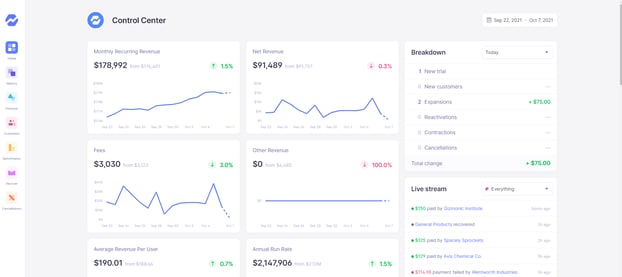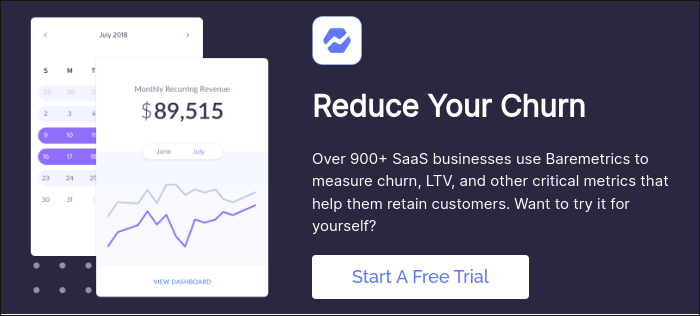Table of Contents

Inbound marketing is the process of getting potential clients to find your company. Since this often happens before customers are considering a purchase, it is often aimed at both getting more visitors to your site and focusing the targets to get the right visitors to your site.
Both of these tasks can rely on content marketing, for example events, podcasts, blogs, and social media posts. Proper targeting of your search engine optimization (SEO) through keyword mining involves not just getting more views in Google results but also the right views. It is not enough to just get as many eyes on your site as possible (although that is nice)—you need to get those visitors with needs that your platform meets. To do this right, you’ll need to really define your ideal customer profile (ICP).
Whatever marketing strategy you choose, use Baremetrics to monitor your sales data.
Baremetrics makes it easy to collect and visualize all of your sales data. When you have many clients, it can be difficult to calculate your MRR, ARR, LTV, and so much more.
Thankfully, there is Baremetrics to do all of this for you.
Your SaaS company likely uses a CRM and/or payment processing software, and the data required to compute these core metrics can be all over the place. Integrating innovative software that can cull MRR values from CRM and payment processing systems is a valuable shortcut. Here too, Baremetrics can do all this for you.
Integrating this innovative tool can make financial analysis seamless for your SaaS company, and you can start a free trial today.
Inbound marketing basics
Inbound marketing focuses on visibility, in contrast to outbound marketing, which focuses on finding customers. Indeed, inbound marketing is designed around developing relationships, building awareness, and generating leads. This has a few specific advantages.
The first is that inbound marketing is completely organic, and therefore it is all about the quality of your marketing strategy and not the amount you spend. So long as you are putting good content out there, you will build viewership and that will further improve your site’s performance.
Another major advantage is that customers do not feel like they are being sold to. This can lead to some brand loyalty when they are ready to make a purchase. It also means they might be inclined to spend more time on your site, read other blogs, and bookmark you for future references.
There are three main ways that inbound marketing can be applied:
-
Attract: Your aim here is to attract the right people to your site by providing content that is specifically interesting and useful to them. The goal is to become a trusted reference site to have them come back over and over.
-
Engage: Next, you want to show that you both understand their business and offer value to them. You can do this by showing that you know their pain points and current needs, and that your platform provides solutions to these problems.
-
Delight: This is where you offer your potential clients help and support so that they are happy to make a purchase. Continuing after the purchase, this is also building relationships with your clients so that they can succeed using your product. You want them to actually solve those problems they have been having.
As a final point, inbound marketing can work within your funnel and flywheel, but since we’ve written extensively about that before, let’s move on to understanding attract, engage, and delight in detail.
Attract
Attracting customers is a two-step process. First, you need to figure out who your customer is. The more specific and accurate you can make your ICP, the more likely it is that you are going to appear in the search engine results page (SERP) of your prospective clients.
The ICP should include everything from the location and demographic of your prospective clients to their industry, the issues they are facing, and the kinds of knowledge they need to succeed in that industry. Keep in mind that having several ICPs is often more beneficial than having a very amorphic or overly broad ICP.
The second step is content production. On the web, content is king. Depending on your targeted clientele, the content you produce could be photos, blogs, online events, webinars, social media posts, podcasts, YouTube videos, or any of the myriad other things people consume online.
Having great content, produced with SEO in mind, and aimed at accurate ICPs is the key to attracting people—the right people—to your product.
Engage
The next part of inbound marketing is to get your potential customers to engage with your product. While getting your clients to engage with your product is the goal, to succeed with inbound marketing it is better to focus on the problems your potential clients might have and how your product solves these issues.
This is sometimes called solution selling, that is you verbalize the pain points of your customers’ business processes and how your product is a solution to those problems.
Note, however, that this is not about deception! You do not want to trick your clients into signing up, as that will just result in refunds, churn, and bad publicity. In a subscription revenue model, there is nothing more important than relationships, and relationships are built on trust. Think of solution selling as more about selling your product through real examples and framing it within the needs of your customers.
Delight
As just mentioned, the SaaS market is built on relationships. The longer you keep those relationships, the more profitable your company will be. Since customer acquisition costs (CAC) are often a third of the customer lifetime value (LTV) (or even more), it will always be cheaper to keep your current customers supported, satisfied, and happy (or delighted) than to find a replacement.
To delight your customers, have your team act as advisors and experts on your platform to make sure each client is getting as much out of their subscription as possible.
Surveys, educational emails, chatbots, and even responsive development that expands the most liked products and simplifies the user experience are all ways to keep your customers happy.
Many customers looking for immediate help go to Twitter to send a message instead of email or picking up the phone. Keeping any eye on every possible communication channel is an important part of delighting customers.
Strategize for growth months and years down the road
Get deep insights into MRR, churn, LTV and more to grow your business
Planning, implementing, and optimizing your inbound marketing program
Inbound marketing can be a complex strategy. Whether you are new to marketing or coming from a more traditional company, the bootstrapping feel of an inbound marketing strategy can make it particularly difficult to understand.
Breaking down the inbound marketing strategy into five simple steps can make it easier.
Step 1. Define your business aims and ICPs
You need to understand your customers and what they need to attract them to your site. If you don’t have a well-defined ICP, then you’ll be getting the wrong visitors to your page.
Step 2: Provide content for every stage of your customers’ journey
Whatever type of content you produce, whether it is audio, visual, or plain blogs like this one, be sure your inbound marketing strategy provides helpful information during their entire journey.
Knowing their pain points or interests today is a great start, but predicting the issues they’ll have in six months or three years will mean they keep coming back to your site. Prospective clients that frequent your page regularly are far more likely to trust you enough to give your platform a try.
Similarly, current clients that are more engaged in your services and more interested in the content you are releasing are more likely to stick around and even provide helpful feedback and suggestions.
Step 3: Choose your delivery platform(s)
While the shotgun approach guarantees that no prospective client is left hidden from your messaging, learning each social media site’s personal culture or how to write for each content delivery type requires time and effort—two finite resources in the fast-paced SaaS world. If your ICP says TikTok, LinkedIn, or Twitter is where your clients are most likely to be engaged with content creators, then taking a deep dive into that culture is going to pay off manifold.
Step 4: Create and follow through on your content calendar
Understanding when your prospective customers are online and timing your content release to their schedule can increase the odds they see and therefore engage with your messaging.
In addition, maintaining a consistent content release schedule will improve the visibility of your content overall. Make a schedule and then stick to it.
Step 5: Analyze results and optimize your inbound marketing strategy
You can’t evaluate your inbound marketing strategy without good metrics, and you can’t optimize it without tracking your metrics over time. That’s where Baremetrics comes in.
Baremetrics does all the heavy lifting for you, intelligently “automating away” meaningless numbers to uncover the true, bigger picture. The crystal-clear dashboard gives you a holistic view of your revenue, expenses, and profit for a specified period. This allows you to quickly evaluate the results of your inbound marketing strategy.
Baremetrics gives you all the key metrics for your business, including MRR, ARR, LTV, total customers, and more.




